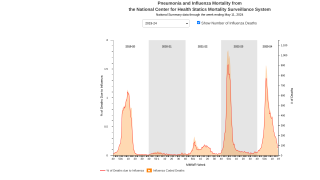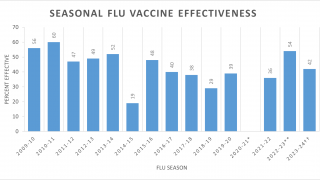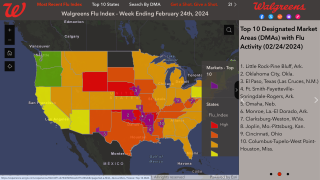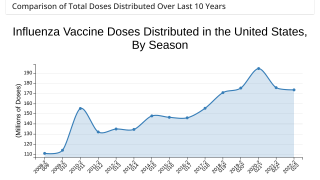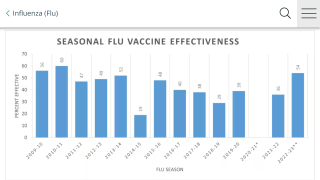Don't Invite the Flu to Thanksgiving

The Thanksgiving holiday has arrived and so has the 2019-2020 flu season.
Since the flu season is just getting started in most areas of the USA, it's not too late to get a flu shot, said the Centers for Disease Control and Prevention (CDC) on November 22, 2019.
The CDC continues to recommend influenza vaccination for almost everyone over the age of 6 months.
The CDC also suggests pregnant women get a flu shot and not the nasal spray influenza vaccine for the current flu season.
The CDC recommends the use of any licensed, age-appropriate influenza vaccine during the 2019-2020 influenza season, including inactivated influenza vaccine, recombinant influenza vaccine, or live attenuated influenza vaccine, with no preference expressed by the CDC.
Both the trivalent (2-component) and quadrivalent (4-component) influenza vaccines will be available.
This short CDC video says ‘its always best to prevent flu and its potentially serious complications with a flu shot.
During Week #46, the CDC share highlights:
- Nationally, influenza-like illness (ILI) activity has been at or above baseline for the past 2 weeks,
- A key indicator that rose last week is the percentage of respiratory specimens testing positive for flu, which reached 7.3 percent,
- The amount of influenza activity across the USA varies, with the southern states and parts of the western region seeing elevated activity,
- There is significant co-circulation of influenza A(H3N2), A(H1N1)pdm09 and B/Victoria viruses, with leading virus type varying by region and age group,
- For the first time this season, the CDC reported on hospitalizations, based on data through November 16th, that the overall rate is 1.4 per 100,000 population, which is similar to recent seasons. The highest hospitalization rates are in seniors.
- Of hospitalizations, 62.6 percent were linked to influenza A,
- Influenza B is the most commonly detected strain, accounting for 73.7% of viruses at clinical labs and 63.9% of flu viruses at public health labs. This report is unusual at the start of the flu season, as the viruses typically rise toward the end of the flu season. However, the 2018-2019 season was unusual, because the United States experienced very little influenza B, but saw two waves of influenza A activity, the 1st from 2009 H1N1 and the 2nd one involving H3N2.
During week 46, the following ILI activity levels were experienced by these states:
- High – Puerto Rico and seven states (Alabama, Arkansas, Georgia, Mississippi, Nevada, South Carolina, and Texas)
- Low – New York City and 12 states (Alaska, Arizona, California, Colorado, Connecticut, Hawaii, Maryland, New Jersey, New Mexico, Oklahoma, Tennessee, and Virginia)
- Minimal – the District of Columbia and 30 states (Delaware, Florida, Idaho, Illinois, Indiana, Iowa, Kansas, Kentucky, Maine, Massachusetts, Michigan, Minnesota, Missouri, Montana, Nebraska, New Hampshire, New York, North Carolina, North Dakota, Ohio, Oregon, Pennsylvania, Rhode Island, South Dakota, Utah, Vermont, Washington, West Virginia, Wisconsin, and Wyoming)
- Data were insufficient to calculate an ILI activity level from the U.S. Virgin Islands and one state (Louisiana).
Unfortunately, 1 additional influenza-associated pediatric fatality was reported to CDC during Week #46. As of November 16th, there have been 4 confirmed pediatric fatalities this flu season.
Recent flu news
- Healthcare providers should emphasize influenza vaccination for e-cigarette or vaping lung injury (EVALI) patients
- Texas confirmed 17 influenza-associated pediatric fatalities during 2018-2019 flu season
- Adjuvant azoximer bromide found to have many benefits in vaccine efficiency
A respiratory illness this winter might be the flu if you have a fever, cough, sore throat, runny or stuffy nose, body aches, headache, chills, and fatigue.
In addition, other viruses can also cause respiratory illness similar to the flu.
So, it is impossible to tell for sure if you have the flu based on symptoms alone. If your doctor needs to know for sure whether you have the flu, there are laboratory tests that can be done, says the CDC.
> Click here for a flu test from UltaLabs <
Most flu vaccines protect against 4 different influenza viruses for the 2019-2020 flu season.
Since any vaccine can cause a side effect, vaccination decisions should be part of an ongoing discussion between a provider and patient, says the CDC.
2019-2010 flu news is published by Precision Vaccinations.
Our Trust Standards: Medical Advisory Committee















